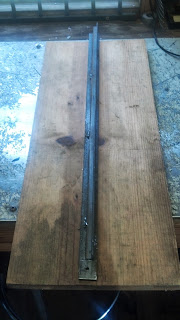It's not the wife's fault that things are as bad as they are- she's not a handyman and she really had no assistance with anything of this nature until I arrived on the scene. Progress is being made and I enjoy working on tasks such as this, especially considering what it would cost to have someone else do it.
Have I mentioned that I hate paying someone to do things I can do? ;)
The garage side of the house is the last one that could be seen from the street which hadn't been worked on yet. This was due to the fact that it was in the LEAST bad shape. I actually did an area on the back of the house because things there were so bad I didn't feel comfortable waiting any longer. But the next door neighbor has been having her house roofed and painted and considering that the garage side faces her house I decided to take care of it this past weekend.
So it started out looking like this:
If you will notice, the cardboard that was used for the "wings" (as I call them, not sure what the actual term is) was rotten and wavy, so I started by replacing both of those with plywood. That would be the unpainted plywood piece that you can see in the top left of the picture above. I replaced the right one as well. Those trim boards and wings are cut out of one long piece of cardboard, so I took my oscillating too and cut out the old stuff and made new to replace it using templates that I had traced earlier. Oscillating tools are awesome for this kind of thing! I refer to the trim as cardboard because it's not even pressboard. It's more along the lines of cardboard fibers bonded together rather than actual wood chips like you find in pressboard. Probably a lot cheaper, but I've been using actual wood when it needs to be replaced.
Here's a better shot of the wing:
In the first picture you can see the holes and peeling layers of the plywood (especially noticeable under the window). There were actually 4 full sheets that needed to be replaced.
Next task was to pull the window and the old wood off of the house. Then I cleaned out between the studs and put backing on several largish holes in the sheet rock so that I can patch them properly from the inside once I am done with the outside. I replaced the pipe belonging to the hose bib (made it longer and it was rusting on the inside anyway) and put a new faucet on the pipe.
Now for the fun part- putting new wood in place. While it may seem a rather straight-forward task you need to realize that each piece of wood slides UNDER the one above it, the interlocks with the one on each side of it. So there are three joints to work with. Not bad if you're putting it up as new construction, but a true pain-in-the-ass to do it as re-work. By myself. Alone.
By the end of the second day my muscles were so tired that I seriously had trouble carrying my tools to put them back where they go. But the work got done :)
A shot of the new panels in place:
Thank the powers that be for nail guns. I'd be two more weekends getting this done if I had to drive all of the nails by hand! But the nail gun can be picky. You can set it to a general pressure that works for most situations or you can spend loads of time adjusting the thing to drive the nails in just right. I leave it on the generally setting which countersinks the nails just a bit and then I putty over the nail heads before painting (as shown below). This keeps the nails from popping out and rusting like they will if you just drive them flush and paint them.
The remainder of the day after applying the putty to the nails was used painting the stripes between the "boards" on the plywood. Note: Before putting the wood on the house I primed both sides and all of the edges with a good primer. That served two purposes- 1) It keeps the wood from warping as it will when only one side is painted, and 2) It beats the hell out of rolling and brushing the primer on in a vertical situation. Priming the edges also keeps the wood from rotting as fast at the bottom once it's installed.
The next day after work I painted all of the siding. It went rather quickly since I was now using a roller and all of the trim painting had been done the day before. I didn't bother painting inside of the marks I had for the window opening:
If you look closely you can see the holes I drilled in the corners of the window layout so I could redraw the lines and cut out the opening with a minimum of fuss. Next part of the project was re-installing the vent cover and the window. I simply drew lines to the edges of each hole, set my saw to the depth of the plywood, and cut the excess away with no issues. After cleaning up the window and putting some flashing into the opening I installed and sealed it:
I cut, primed, and painted the trim boards for the right edge of the house and around the window. The following day I installed the remaining trim and put the fence panel back into place:
Mission accomplished! I spent a total of $250 on paint and materials and I probably saved between $600-$1200 in the labor costs.














